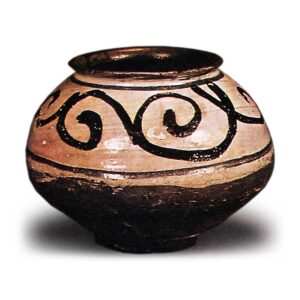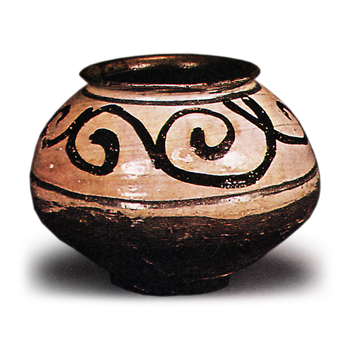
The remains of numerous kilns dating from the late Goryeo Dynasty to recent years are located on the foot slope of Georyongsan Mountain, 16 kilometers southeast of Gongju, Chungcheongnam-do, Korea. The pottery discovered here is commonly referred to today as Joryongsan Sangdo.
It can be said that the techniques introduced from both the north and south of China were combined here. The pottery excavated from the kiln site comes in a wide variety of shapes, with the following six types of pottery.
Mishimategate: The design was pressed into the surface of the vessel using a mold, with dotted or wavy lines or horizontal lines of serpentine, swordpoint, or lightning patterns, and then white clay was applied over the surface to fit into the recesses, after which the white clay outside the design was scraped off and glazed and fired. Some pieces were carved with spatulas with dragon, willow petal, or peony designs, and white clay was applied over the carved design to fit it into a recess, and then glazed. There are also some with a mishimate pattern on both the interior and exterior surfaces. A dense pattern of small and fine flowers or a series of butterfly-shaped patterns is separately called hana-mishima. Some of them often have characters between the patterns. These characters are written in white inlay as “Gyeongju Jangheunggang,” “Changwon Jangheunggang,” “Jangheunggang,” “Jangan Gokmikgu,” “Naizen,” “Naebyeom,” or in iron glaze as “Reibin,” “Naesijsa,” “Hongji,” “Dai,” etc. Those with the characters “Changxinggou,” “Naish膽,” “Reibin,” and “Naisaiji” were instruments used by the official in charge. Only a few bowls and bowls with “戒” and “果” written on them were found with characters other than Mishimategate. Fragments of tombstone inscription plates with the year inscriptions “Seika 23,” “Koumyou Koji 3,” and “Jiajing 15,” as well as many other fragments of tombstone inscription plates, were also found in Hebong-ri, Antipo-myeon.
The clay was gray and the layers were coarse and unattractive, so white clay was applied to the surface of the vessel in a single stroke with a strong brush, and the glaze was then applied to the surface and fired.
Some pieces have clear brush marks. The patterns include lotus flowers, arabesques, grasses, leaves, diamond shapes, and fish.
Carved Mishima: White clay was applied to the surface of the clay, a spatula-like object was used to draw patterns on the surface to reveal the clay, and the piece was then overglazed and fired. The patterns are very coarse and bold, and often include twin fish, leaves, arabesques, lotus petals, and the like. Effects, etc. [Black glaze] Iron glaze was applied over the clay, and its glaze band is brownish-black glaze. In general, those found on the antipura surface were over-fired by placing several pieces of silica sand under the elevated base without using a saggars, but only for this type of ware, for the most part, a white clay band was drawn at once on the bottom of the vessel with a brush instead of silica sand and then over-fired there.
White porcelain with a slight bluish tinge was discovered at the site of a pottery kiln in Antipuramyeon. The clay is blue-grayish-white and hard and tight. This type of ware was previously thought to be later than Mishimategate and Hakeme, but excavation results revealed that they were fired at the same time.
However, the production techniques, glazes, and patterns of these wares are very different from those of Goryeo celadon wares. The pieces excavated from the Binpu-myeon kiln site show the most excellent, detailed, and magnificent characteristics of Mishimate and Hakemoku. The pottery is clearly produced in the early Yi Dynasty, as evidenced by the inscriptions on the excavated tombstone pottery plates and the presence of Yi Dynasty official inscriptions on the wares. The mishima handles and brush marks are slightly deeper than those on Goryeo celadon wares, and the thicker texture is due to the nature of the technique, while the plateau is magnificent. (Report on the Survey of Ceramic Kiln Digs at the Foot of Mt.)



